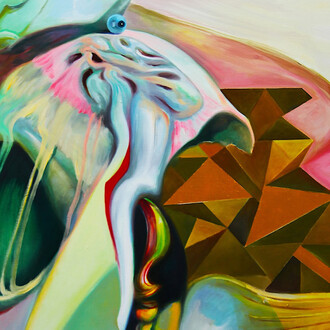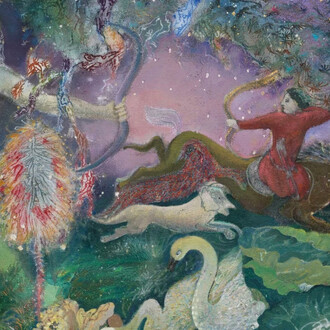Lincoln Glenn Gallery presents Color field queens, an exhibition of works by Alice Baber, Beryl Barr-Sharrar, Sherron Francis, Dorothy Fratt, Sheila Isham, Emily Mason, Betty Parsons, Vivian Springford, Hilda Shapiro Thorpe, and Takako Yamaguchi. The ten artists in the presentation are united not only by gender, but also by their significant and underappreciated contributions to the Color Field movement in the 1970s.
The term Color Field Painting was coined by American critic Clement Greenberg on the occasion of a 1964 exhibition at the Los Angeles County Museum of Art. In considering the selection of works from the 1970s presented in Color field queens in the terms of Greenberg’s definition of Color Field painting, key techniques and attributes unify these artists under Greenberg’s movement. In many of the works, paint is thinned into delicate washes and blooming swaths of color. The resultant forms deliver sumptuous tones, uninterrupted by brush strokes that would suggest the presence of the hand behind them.
The Color Field movement had robust roots in both Washington D.C. and New York City in the decade leading up to Greenberg’s defining exhibition. In 1957, Sheila Isham (1927–2024) established a studio practice in D.C. and joined a group known as the Society of Washington Printmakers. In the same period, D.C. native Dorothy Fratt (1923–2017) began showing as a student in D.C. at the Corcoran School of Art and the Phillips Collection, ultimately joining the group that would become the Washington Color School.
Color Field painting became formally linked to Washington D.C with the 1965 exhibition Washington Color Painters at the Washington Gallery of Modern Art, featuring work by Gene Davis, Morris Louis, and Kenneth Noland, among others. The exhibition solidified the formation of the Washington Color School, uniting a “second generation” of artists in the movement who showed at the Washington Gallery as well as the Jefferson Place Gallery, co-founded by Noland. Hilda Shapiro Thorpe (1920–2000) exhibited regularly in this cohort alongside the highest-profile woman tied to the movement, Alma Thomas.
“A good part of the reaction against Abstract Expressionism is, as I've already suggested, a continuation of it”, wrote Greenberg; as such, in addition to D.C., the Color Field movement had a robust presence in the birthplace of Abstract Expressionism, New York City. During this key period of growth for the Color Field movement, Vivian Springford (1913–2003) remained an active member of the local artist community, shifting from showing at the Great Jones Gallery, the Preston Gallery, and the Visual Arts Coalition.
Around this same time in the 1960s, Beryl Barr-Sharrar (b. 1935) was living and working in Paris, where she encountered notable American artists working in a similar visual language, including Sam Francis, Joan Mitchell, and Alice Baber (1928–1982). Baber spent ample time in Paris as well as in New York, where she co-founded March Gallery, one of the select 10th Street galleries. New York-born Emily Mason (1932–2019), another member of the grouping, ran in these same circles, showing at the artist-run Area Gallery.
It is on the heels of this highly generative period of Abstraction in New York that Sherron Francis (b. 1940) moved to Soho in 1968. Joining a community of artists that included Larry Poons, Larry Zox, and Peter Bradley, Francis began showing with Andre Emmerich upon being introduced to the renowned gallerist by fellow artist Dan Christensen in 1971. In 1973, Andre Emmerich Gallery held solo shows of work by Francis, Helen Frankenthaler, Hans Hofmann, and Washington Color School painter Kenneth Noland. Legendary art dealer Betty Parsons (1900 – 1982), whose famed gallery was located on East 57th Street, was also producing colorful found wood assemblages during the 1970s. The youngest artist of this group show, Takako Yamaguchi (b. 1952), was strongly associated with the Pattern and Decoration Movement (P&D), which found its roots in the mid-1970s.
Color field queens reflects Lincoln Glenn Gallery’s core mission to showcase the wide array of American artists who made significant contributions to art history but faced institutional barriers that allowed their names to be forgotten by time.
















